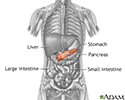Pancreas divisum
Pancreatic divisum
Pancreas divisum is a birth defect in which parts of the pancreas do not join together. The pancreas is a long, flat organ located between the stomach and spine. It helps in food digestion.
Causes
Pancreas divisum is the most common birth defect of the pancreas. In many cases, this defect goes undetected and causes no problems. The cause of the defect is unknown.
As a baby develops in the womb, 2 separate pieces of tissue join together to form the pancreas. Each part has a tube, called a duct. When the parts join together, a final duct, called the pancreatic duct, is formed. Fluid and digestive juices (enzymes) produced by the pancreas normally flow through this duct.
If the ducts do not join while the baby is developing in the womb, pancreas divisum results. Fluid from the 2 parts of the pancreas drains into separate areas of the upper portion of the small intestine (duodenum). This occurs in 5% to 15% of people.
If a pancreatic duct becomes blocked, swelling and tissue damage (pancreatitis) may develop.
Symptoms
Symptoms include:
-
Abdominal pain
, most often in the mid-abdomen, that may be felt in the back
Abdominal pain
Abdominal pain is pain that you feel anywhere between your chest and groin. This is often referred to as the stomach region or belly.
 ImageRead Article Now Book Mark Article
ImageRead Article Now Book Mark Article -
Abdominal swelling
(distention)
Abdominal swelling
A swollen abdomen is when your belly area is bigger than usual.
Read Article Now Book Mark Article - Nausea or vomiting
Note: Unless you have pancreatitis, you will not have symptoms.
Exams and Tests
You may have the following tests:
-
Abdominal ultrasound
Abdominal ultrasound
Abdominal ultrasound is a type of imaging test. It is used to look at organs in the abdomen, including the liver, gallbladder, spleen, pancreas, and...
 ImageRead Article Now Book Mark Article
ImageRead Article Now Book Mark Article -
Abdominal CT scan
Abdominal CT scan
An abdominal CT scan is an imaging method. This test uses x-rays to create cross-sectional pictures of the belly area. CT stands for computed tomog...
 ImageRead Article Now Book Mark Article
ImageRead Article Now Book Mark Article -
Amylase
and
lipase
blood test
Amylase
Amylase is an enzyme that helps digest carbohydrates. It is made in the pancreas and the glands that make saliva. When the pancreas is diseased or ...
 ImageRead Article Now Book Mark Article
ImageRead Article Now Book Mark ArticleLipase
Lipase is a protein (enzyme) released by the pancreas into the small intestine. It helps the body absorb fat. This test is used to measure the amou...
 ImageRead Article Now Book Mark Article
ImageRead Article Now Book Mark Article - Endoscopic retrograde cholangiopancreatography (ERCP)
- Magnetic resonance cholangiopancreatography (MRCP)
- Endoscopic ultrasound (EUS)
Treatment
The following treatments may be needed if you have symptoms of the condition, or if pancreatitis keeps returning:
- ERCP with a cut to enlarge the opening where the pancreatic duct drains
- Placement of a stent to prevent the duct from getting blocked
You may need surgery if these treatments do not work.
Outlook (Prognosis)
Most of the time, the outcome is good.
Possible Complications
The main complication of pancreas divisum is pancreatitis.
When to Contact a Medical Professional
Call your health care provider if you develop symptoms of this disorder.
Prevention
Because this condition is present at birth, there is no known way to prevent it.
References
Forsmark CE. Pancreatitis. In: Goldman L, Schafer AI, eds. Goldman's Cecil Medicine . 25th ed. Philadelphia, PA: Elsevier Saunders; 2016:chap 144.
-
Digestive system - illustration
The esophagus, stomach, large and small intestine, aided by the liver, gallbladder and pancreas convert the nutritive components of food into energy and break down the non-nutritive components into waste to be excreted.
Digestive system
illustration
-
Endocrine glands - illustration
Endocrine glands release hormones (chemical messengers) into the bloodstream to be transported to various organs and tissues throughout the body. For instance, the pancreas secretes insulin, which allows the body to regulate levels of sugar in the blood. The thyroid gets instructions from the pituitary to secrete hormones which determine the pace of chemical activity in the body (the more hormone in the bloodstream, the faster the chemical activity; the less hormone, the slower the activity).
Endocrine glands
illustration
-
Pancreas - illustration
The pancreas is an elongated, tapered gland that is located behind the stomach and secretes digestive enzymes and the hormones insulin and glucagon.
Pancreas
illustration
-
Digestive system - illustration
The esophagus, stomach, large and small intestine, aided by the liver, gallbladder and pancreas convert the nutritive components of food into energy and break down the non-nutritive components into waste to be excreted.
Digestive system
illustration
-
Endocrine glands - illustration
Endocrine glands release hormones (chemical messengers) into the bloodstream to be transported to various organs and tissues throughout the body. For instance, the pancreas secretes insulin, which allows the body to regulate levels of sugar in the blood. The thyroid gets instructions from the pituitary to secrete hormones which determine the pace of chemical activity in the body (the more hormone in the bloodstream, the faster the chemical activity; the less hormone, the slower the activity).
Endocrine glands
illustration
-
Pancreas - illustration
The pancreas is an elongated, tapered gland that is located behind the stomach and secretes digestive enzymes and the hormones insulin and glucagon.
Pancreas
illustration
Review Date: 10/27/2015
Reviewed By: Subodh K. Lal, MD, gastroenterologist with Gastrointestinal Specialists of Georgia, Austell, GA. Review provided by VeriMed Healthcare Network. Also reviewed by David Zieve, MD, MHA, Isla Ogilvie, PhD, and the A.D.A.M. Editorial team.



